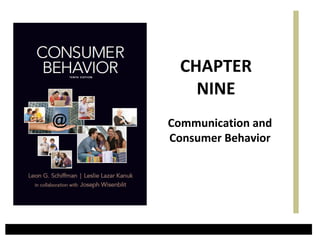Chapter ppt 09 - copy-1
- 2. Basic Communication Model Figure 9.2 2Copyright 2010 Pearson Education, Inc. Publishing as Prentice Hall Chapter Nine şÝşÝߣ
- 3. The Source as the Initiator 33Copyright 2010 Pearson Education, Inc. Publishing as Prentice Hall Chapter Nine şÝşÝߣ
- 4. The Source - Impersonal and Interpersonal Communications • Source Credibility • Reference Groups – Normative – Comparative – Membership – Symbolic 44Copyright 2010 Pearson Education, Inc. Publishing as Prentice Hall Chapter Nine şÝşÝߣ
- 5. • Informal Sources – Opinion leaders • Word of Mouth and eWOM – Two-way communication – Social networks – Brand communities – Message boards and Blogs 5 The Source Informal Sources and Word of Mouth 5Copyright 2010 Pearson Education, Inc. Publishing as Prentice Hall Chapter Nine şÝşÝߣ
- 6. • Buzz Agents • Viral Marketing • Tackling negative rumors 6 The Source Word of Mouth – Strategic Applications 6Copyright 2010 Pearson Education, Inc. Publishing as Prentice Hall Chapter Nine şÝşÝߣ
- 7. • Institutional advertising • Publicity • Endorsers 7 The Source Credibility of Formal Sources 7Copyright 2010 Pearson Education, Inc. Publishing as Prentice Hall Chapter Nine şÝşÝߣ
- 8. Discussion Questions • Who do you consider to be a credible spokesperson(s)? • Why? • Can you think of certain ads with credible spokespeople? • Ads with spokespeople who are NOT credible? 8Copyright 2010 Pearson Education, Inc. Publishing as Prentice Hall Chapter Nine şÝşÝߣ
- 9. Credibility of Formal Sources Endorser Effectiveness 99Copyright 2010 Pearson Education, Inc. Publishing as Prentice Hall Chapter Nine şÝşÝߣ
- 10. 10 Credibility of Formal Sources Other Credibility Sources 10Copyright 2010 Pearson Education, Inc. Publishing as Prentice Hall Chapter Nine şÝşÝߣ
- 11. The Receivers as the Target Audience • Personal characteristics and motives • Involvement and congruency • Mood • Barriers to communication – Selective exposure to messages – Psychological noise 11Copyright 2010 Pearson Education, Inc. Publishing as Prentice Hall Chapter Nine şÝşÝߣ
- 12. Overcoming Psychological Noise 1212Copyright 2010 Pearson Education, Inc. Publishing as Prentice Hall Chapter Nine şÝşÝߣ
- 13. Media (Channel) • Mass Media • Nontraditional (New) Media is: 1313Copyright 2010 Pearson Education, Inc. Publishing as Prentice Hall Chapter Nine şÝşÝߣ
- 14. The Shift From Traditional To Nontraditional Advertising Is Growing - Figure 9.5 1414Copyright 2010 Pearson Education, Inc. Publishing as Prentice Hall Chapter Nine şÝşÝߣ
- 15. Nontraditional Media • Out-of-home and On-the-go – Advertising screens in buildings and transit – Digital billboards on roads – Ambient advertising (in new places) • Online and Mobile – Includes consumer-generated media – Narrowcast messages • Interactive TV (iTV) 1515Copyright 2010 Pearson Education, Inc. Publishing as Prentice Hall Chapter Nine şÝşÝߣ
- 16. Designing Persuasive Communications • Resonance • Message framing • One-Sided versus Two- Sided Messages • Order Effects • Wordplay • Used to create a double meaning when used with a relevant picture Message Structure and Presentation 16Copyright 2010 Pearson Education, Inc. Publishing as Prentice Hall Chapter Nine şÝşÝߣ
- 17. Ads That Show Resonance 1717Copyright 2010 Pearson Education, Inc. Publishing as Prentice Hall Chapter Nine şÝşÝߣ
- 18. Designing Persuasive Communications • Resonance • Message framing • One-Sided versus Two- Sided Messages • Order Effects • Positive framing • Negative framing Message Structure and Presentation 18Copyright 2010 Pearson Education, Inc. Publishing as Prentice Hall Chapter Nine şÝşÝߣ
- 19. Designing Persuasive Communications • Resonance • Message framing • One-Sided versus Two- Sided Messages • Order Effects Depends on nature of the audience and nature of competition Message Structure and Presentation 19Copyright 2010 Pearson Education, Inc. Publishing as Prentice Hall Chapter Nine şÝşÝߣ
- 20. Designing Persuasive Communications • Resonance • Message framing • One-Sided versus Two- Sided Messages • Order Effects • Primacy • Recency • Order of benefits • Brand name Message Structure and Presentation 20Copyright 2010 Pearson Education, Inc. Publishing as Prentice Hall Chapter Nine şÝşÝߣ
- 21. Advertising Appeals • Comparative • Fear • Humor • Abrasive • Sex • Audience participation • Timely • Celebrities 2121Copyright 2010 Pearson Education, Inc. Publishing as Prentice Hall Chapter Nine şÝşÝߣ
- 22. Comparative - It Has Positive Effects On Brand Attitudes, Purchase Intentions, and Purchases 22Copyright 2010 Pearson Education, Inc. Publishing as Prentice Hall Chapter Nine şÝşÝߣ
- 23. Two Advertising Appeals Are Shown in This Ad-Humor and Fear 23Copyright 2010 Pearson Education, Inc. Publishing as Prentice Hall Chapter Nine şÝşÝߣ
- 24. Types of Celebrity Appeals Table 9.6 2424Copyright 2010 Pearson Education, Inc. Publishing as Prentice Hall Chapter Nine şÝşÝߣ
- 25. Feedback Determining Effectiveness 25Copyright 2010 Pearson Education, Inc. Publishing as Prentice Hall Chapter Nine şÝşÝߣ
- 27. Chapter 9-1: The Viewer’s Voice Influences TV Programming 1. Communication Feedback 2. Should programmers and producers consider the feedback? 3. Source Credibility 4. Compare and contrast Neilsen ratings and TWOP for a given episode. 27



























